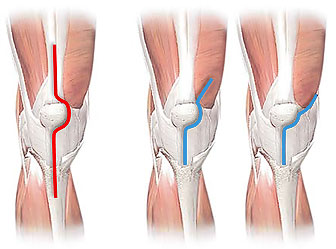Knee joint, which is one of the most important weight-bearing joint in human body, is made of 3 bones and a kneecap, known as patella. There are a number of muscles, tendons and ligaments, which aid in increasing its stability. Finally the whole joint is bathed in a lubricating fluid called as synovial fluid, which ensures friction less movement of the joint.
What is Knee replacement surgery?
This procedure also referred to as knee arthoplasty involves removal of the damaged joint and replacing it with prosthesis. Teflon or Polyethylene is used for making the prosthesis
There are 2 kinds of knee replacement surgeries. Total knee replacement (TKR) means replacing both sides of the knee joint, and partial knee replacement (PKR) means removing just one side of the joint.
How does a knee joint get damaged?
As observed in patients all over the world, most common cause of knee damage is arthritis. There are 3 variations of arthritis, all of which can afflict a knee. They are:
- Rheumatoid arthritis results in chronic inflammation that damages the knee joint
- Osteoarthritis is age related degenerative change of bones and joints
- Severe Traumatic arthritis in the form of ligament tear and knee break can erode the knee cartilage over a period of time.
Does everyone with knee injury or arthritis need replacement?
Orthopedic surgeons all over the world and knee replacement surgeon in Delhi use certain criteria to choose a patient for knee replacement. They are:
- Continuous but moderate knee pain, even while resting or sleeping
- Stiffness and severe knee pain to the extent that it undermines the patients ability to complete routine everyday activity like walking, getting up from a sitting position, climbing the stairs and so on and so forth
- Chronic swelling and knee inflammation
- Knee deformity
- All other treatment modalities failed.
What happens during the procedure?
Today, minimally invasive technique guided by computer navigation system is employed for knee replacement. A small incision of 3-4 inches is made at the offending knee joint. From this small incision, the surgeon then passes specially designed surgical instruments inside the joint cavity, along with an arthroscope. The arthroscope is fitted with a small magnifying camera at the front that projects images to a computer screen.
The surgeon then removes the damaged bone, replaces it with the prosthesis and cements it in its place.
Recovery post procedure
Patient is started on physiotherapy as early as next day. Early mobilization is crucial as this helps in reducing post surgery stiffness, which can compromise mobility of the new prosthesis. Patient is advised to follow the following:
- Strict adherence to physiotherapy schedule
- Avoid lifting heavy things and do everything possible to avoid an accidental fall
- Routine wound/scar care
- Keep leg elevated and avoid standing for long periods
- Use crutches and support to walk till knee is strong again
- Look out for sings of infection, breathing difficulty and blood clots
Risks and Complication
Some complications that might arise post surgery are:
- Infection of the wound
- Patient is allergic to bone cement
- Fracture of the bone around the joint
- Dislocation of the knee cap
- Stiffness and loss of motion
- Bleeding, numbness around the knee joint



